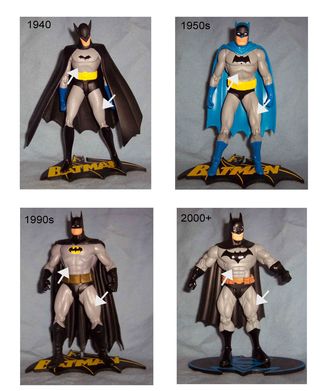Body Image
Batman and Body Image: Inner Physical Capacity Not Outward Appearance
Appearance doesn't define function and fitness.
Posted March 3, 2022 Reviewed by Lybi Ma
Key points
- Fitness and function of the human body cannot be determined by physical appearance
- Bodies and brains are the product of the experiences and training they undergo.
- Unrealistic physical portrayals of iconic characters can have negative impact on others.
- Where characters are meant to represent real humans, realistic training and body outcomes should be depicted.
We are a very visual species. This is not a huge newsflash, of course. We have evolved to rely heavily on vision as a sensory modality. It's also a modality that's easy to confuse and subject to illusions and errors. What you see isn't what you always get, as anyone who's seen a magic show knows. This is especially the case when we think about physical capability and function of human bodies and make judgments about their perceived capacity.
Body form is created by what we do, not how we want to seem
Like all biological bits, tissues and the bodies they make up, adapt to how they are used. The stresses and training that a person experiences cause bodies to adapt their form and function to support the training. It's a stimulus-response scenario. This is important because most of what we see in modern media is based on trying to create a body that doesn't have a function beyond how it looks.
That person "looks fit" or "looks healthy" have become stand-ins for "that person looks good and is a good person". Of course, all of this is absurd because visual appearance tells you nothing about health or fitness because these relate directly to function, not form. It really is what's inside that counts.
Batman went from reasonable to unrealistically ripped
I thought a lot about the false separation of form and function in media when I was writing Becoming Batman: The Possibility of a Superhero. Writing that book involved going back to the original comics and reading forward for clues on Batman's training history. I was struck by how the earlier representations of Batman as a person were definitely within the range of expected human dimensions in the 1940s and 1950s but morphed into later versions in the 1990s and beyond 2000 of a hugely distorted and impossible to achieve physique. He became a hulking steroid monster with likely surgical implants that was not a product of any of the kinds of training Bruce Wayne would do to become Batman.

This image is a panel from Becoming Batman showing four action figures representing the artwork of the Batman comics from the 1940s through to 2000+. The "original" Batman is shown at far left and has muscle definition and bulk that are extremely different compared with the 2000+ version. Over time there has been an increasing and unrealistic emphasis on the size and definition of Batman's muscles.
The size of Batman's muscles would only be a relevant outcome of the training required to become Batman if what he did was only lift heavy objects all day. Like as if Batman was a local moving company that has one employee who comes and does the heavy lifting for you all day. Every day. But that's not actually what Batman does so it makes no sense to show him with a physique that is disconnected from and useless in application to how he functions.
The Dark Knight and body dysmorphia
Batman is a martial artist, Parkour agility-master, and all-around athlete. His body, therefore, needs to look like the realistic outcome of the training needed to achieve those capabilities. This is important to reflect on because each of our bodies has the capacity to adapt to what we do for our activities and training. But not everyone's body will turn into the extreme aesthetic of an unrealistic sculpted Greek god.
While preparing for his role as Batman in the 2022 film, Robert Pattinson had some interesting comments. In a 2020 interview with GQ magazine Pattinson said "I think if you're working out all the time, you're part of the problem". He went on to say that 1950s iconic actors like James Dean didn't spend days in the gym to prepare for parts. I don't think it's a coincidence that the aesthetics of '40s and '50s actors were similar to the way other aspects of popular culture, like the body of Batman in the comics, were depicted.
Pattinson took a lot of criticism for his comments and, of course, since he wasn't already an acrobatic martial arts master, some training was needed to portray the character. But the kind of training usually forced on actors playing superheroes in Hollywood films is typically completely disconnected from the functions that those superheroes have and what they actually do. As such, I think Robert Pattinson had it right with his initial comments even if they were grounded in a different approach.
This matters because how ideals are portrayed in popular culture affects the consumers of those portrayals—namely everyone else in society. While body dysmorphia—where imagined flaws in appearance alter eating, activity behaviors, and mental health—is more commonly thought to be an issue for women, it actually is prevalent also in men.
In general, the manifestation of body dysmorphia in women affects almost all aspects of appearance. In men, this can be similar but there's a version, "muscle dysmorphia," that is almost exclusive to men. The way many Hollywood actors, but especially both female and male superheroes, are depicted feeds especially into muscle dysmorphia.
Physical appearance will not protect you from a punch
It's important that we strive towards not falling for the illusion that we need people to look a certain way to be accepted for what they do. Training produces the functional form to more effectively do the training. Old school Batman seemed to understand this a bit. In a story called “Daughter of the Demon” (Batman #232 June 1971), Batman is fighting one of R’as Al Ghul’s main henchmen who is a huge man and very strong. Using typical comic book “banter,” the henchman says to Batman, “I shall dance on your corpse!” Batman says “Not likely! Oh sure, you’re large and powerful…size and strength don’t count for much! Skill is the item. Agility helps too! And those things you lack! You’re clumsy!” Batman correctly tells him that skill and agility are needed for fighting and that skill and agility rely on a body trained to produce those functions.
If your focus is only aesthetic you can achieve your goal just sitting there looking like a nice statue. But if your focus is capacity and capability your eyes are always going to fail you in assessing function and fitness. We need to move beyond focusing on how we look and towards an emphasis on what we can do. In the meritocracy of effort and achievement, we need to rather just do it than only appear like we just did it.
(c) E. Paul Zehr (2022)




